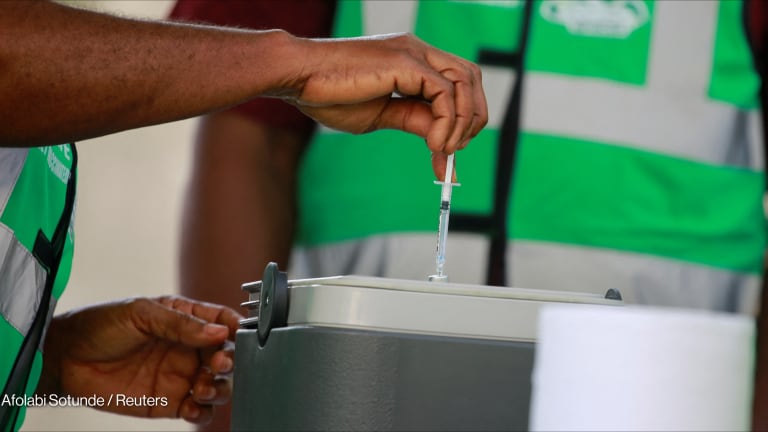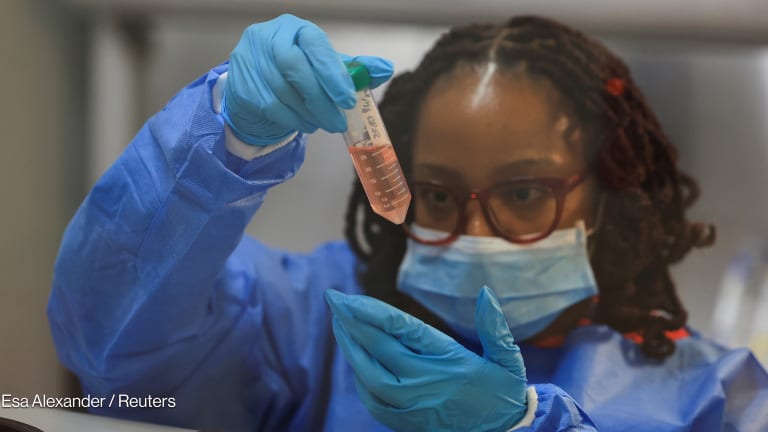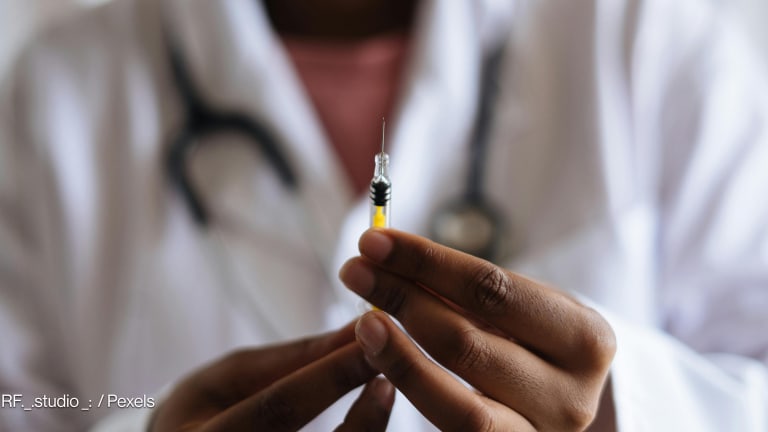
NAIROBI — Last week, Cambodia welcomed a cruise ship that ports in five countries had turned away over fears that some of the passengers might have the novel coronavirus. This week, a passenger from the ship tested positive for the virus after traveling to Malaysia. Now, as people on the ship disperse across the world, there are concerns about how the Cambodian government’s decision could complicate global efforts to contain the spread of the virus, but it also raises concerns over the capacity of the health systems in Cambodia to handle a widespread outbreak.
Coronavirus coverage
► Coronavirus in China: International NGOs' response
► African countries brace for coronavirus spread
► Coronavirus: WHO sets the record straight on facts and misinformation
But Cambodia is not alone. While the vast majority of COVID-19 cases — over 74,600 of the over 75,700 cases — have been contained in China, where the outbreak started at the end of last year, the global health community is concerned that weak health systems could become easily overwhelmed — or even collapse — if the virus spreads in a significant way in other countries.
“We are graced with the fact that China has an advanced health care system and can provide such intensive care to so many. Our fear has always been the disease reaching a country with a weaker health system, who will not be able to mount such a response,” said Dr. Michael Ryan, executive director of the health emergencies program at the World Health Organization, during a press conference Tuesday.
“[Cambodia and Laos] struggle to provide services to their populations even without the threat of a COVID-19 outbreak. If a major epidemic occurs, these health systems could collapse.”
— Tankred Stoebe, emergency coordinator, MSFThis includes countries in South and Southeast Asia, which already have over 160 cases scattered across India, Thailand, Nepal, Sri Lanka, Cambodia, Philippines, Vietnam, Malaysia, and Singapore. Excessive numbers of patients, inadequate protective equipment for health workers and a lack of enough facilities to provide intensive care add to the fears of a contagion that would be hard to control.
“The worst case scenario is just that it runs completely rampant,” said Erica Van Deren, senior program manager, humanitarian and emergency affairs at World Vision.
Weak health systems, vulnerable populations
Cambodia and Laos are particularly vulnerable because of their weak health systems, Dr. Tankred Stoebe, Médecins Sans Frontières emergency coordinator, wrote in a reflection of his visits to countries in the region last week.
“They struggle to provide services to their populations even without the threat of a COVID-19 outbreak. If a major epidemic occurs, these health systems could collapse,” he wrote.
He noted that in the region there are areas where “even simple disease control mechanisms are not yet in place,” warning about the need for preparedness so that health care facilities don’t contribute to the spread of the virus.
“Every country in that region is vulnerable. But the ones that would be most vulnerable are countries where there's more travel from China.”
— Dr. Marcus Zervos, infectious disease specialist, assistant dean of global affairs, Wayne State University School of MedicineEven in countries that have stronger health systems, such as India, there is variability in quality and access to these services including weaker capacity in rural areas, said Dr. Marcus Zervos, division head of infectious diseases at Henry Ford Health System and assistant dean of global affairs at Wayne State University School of Medicine in Michigan, U.S. He works across Asia on building hospital capacity and was in Wuhan, the epicenter of the outbreak, last November before the outbreak hit.
“Every country in that region is vulnerable. But the ones that would be most vulnerable are countries where there's more travel from China,” Zervos said. The government in Bhutan, for example, is very strict on who is allowed into the country, making it less vulnerable, he said.
China is the largest trading partner of Southeast Asian nations and there is an annual travel flow of 65 million visits between the region and China, according to the Association of Southeast Asian Nations.
The low-income, emerging economies of Cambodia, Laos, Myanmar, and Vietnam, in particular, have seen exports to China "boom" in recent years, according to the Yusof Ishaak Institute. Between 2013-2018, exports to China from Cambodia grew 251%, Vietnam grew by 211%, Laos grew by 99%, and Myanmar grew by 82%.
The big concern is that if large numbers of cases emerged, the levels of treatment that people with the virus need — such as supplemental oxygen and intensive care — is not readily available in all parts of the region, Zervos said.
“Many of those countries have very limited ability to care for ICU patients,” Zervos said. “The countries in the region are not going to be like China where they can build two hospitals in two weeks … There's no country that I'm aware of in the world that's able to do that.”
Within the region, people with weak immune systems will be most vulnerable to severe infections. Because of this, MSF, for example, is already speaking with some of its patients, such as its hepatitis C patients in Cambodia, informing them about the symptoms they should watch for.
Another area of concern is densely populated areas, such as the Rohingya refugee camps in Bangladesh, Van Deren said.
“The virus itself will be really scary in a place like the Rohingya refugee camps. People are truly living on top of each other. And in a refugee camp, it’s not like you can store food in your home — you need to leave your home and interact with people to get what you need each day,” she said. “It would stress already stressed systems.”
There are also concerns that in some areas of the region, people may not already have adequate access to clean water — which is key to prevent the spread of the virus, Van Deren said.
Migrant populations would also be vulnerable, said Dr. Abhishek Rimal, emergency health coordinator for Asia Pacific for the International Federation of Red Cross and Red Crescent Societies. Some migrants may not have adequate access to national health care systems because of language barriers, fears about out-of-pocket expenses, and fears over the risk of deportation if they are undocumented, he said. These people are also often living in crowded dormitories, which can further fuel the spread of an outbreak.
There are also concerns that people who are surviving on daily wages won’t be able to provide for families if they become sick, Van Deren said.
Improving health systems, mobilizing communities
WHO has not yet released a list of countries at highest risk in the region based on high volumes of people traveling to and from China, despite releasing these lists for other regions, including in Africa.
Health experts say that the region needs to build up its capacity in order to tackle a widespread outbreak if it were to come. This includes training health workers, increasing diagnostic capacity, and building more isolation units that can provide intensive care.
Health facilities, for example, should have one entry point to ask if patients have symptoms, and if they do, they should be taken to a separate, dedicated area in the facility to be tested, MSF’s Stoebe wrote.
“While this is a simple measure, the fact that it’s not in place shows that the health systems need support,” he wrote. “There’s a lot to be done and we need to use every minute we have to increase the preparedness to fend off an outbreak.”
There is also a need for broader screening to identify cases because the current levels of airport screening — testing for people with symptoms — aren’t effective enough to pick up all of the infections, Zervos said.

In the United States, for example, people with flu-like symptoms in five cities are also being tested for COVID-19 because the symptoms are very similar, he said.
“That's the kind of thing that would be more important for countries in Asia to be doing,” Zervos said. “There's a high likelihood that there's going to be cases that are potentially missed, because there isn’t widespread screening.”
Another concern is that there is a global shortage of personal protective gear — such as masks and gowns — because of the high demand surrounding the outbreak.
“We still can't predict how many cases there are going to be but every estimate looks like this is going to be a continuing problem, which means that [personal protective equipment] will continue to be limited,” Zervos said. “It's difficult to ask a health care worker to care for patients when there's no [personal protective equipment].”
NGOs are also working to build up capacity in the region.
World Vision, for example, is working with its offices in Asia to create detailed response plans. This includes making sure that staff know how to protect themselves from the virus and operationally what would it mean if COVID-19 came to some of these areas. This includes plans based on different tiers of an outbreak — such as if there were one case versus a widespread outbreak.
In the Rohingya refugee camps, there are already strong coordination systems in place, Van Deren said. Actors in the camps are developing awareness messaging that is context-appropriate, he added. There are basic systems of communication already set up with communities that could be used to get messaging out.
“We already have childhood protection committees … they could easily be mobilized for protecting children on health issues,” Van Deren said. They are also working with health workers from the refugee community which could be used to mobilize and educate people on COVID-19.
IFRC is working with national red cross societies to prepare. This includes crafting key messages for communities in areas such as how to prevent the spread of the virus and how to properly use protective gear, translated into local languages. Red cross societies are also working with governments to identify gaps and to make plans for a scale-up. The Nepal Red Cross Society has started training its volunteers to prepare them to respond to an outbreak.
IFRC is also considering training people that could provide home-based care in the event that health systems could become overwhelmed. These volunteers would provide care for mild cases at home.
Moving forward, it will be crucial that NGOs, local government and other responders in the region have one concrete plan and that they follow that plan in coordination with one another, Rimal said.
“At this juncture of the COVID-19 outbreak — it can go anywhere. To be very honest with you, it can really climb up or it can slowly plateau and then die off and then it can reappear at some other point in time,” he said. “We have to prepare for all possible scenarios.”








